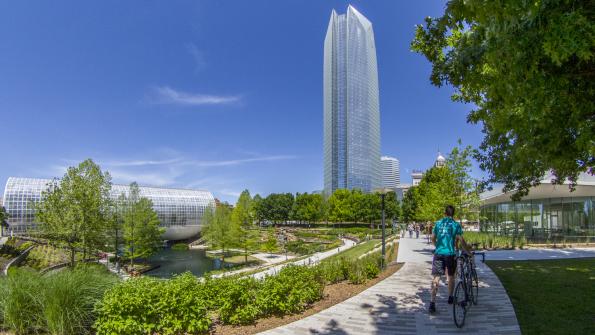Getting downtown back on its feet
In the early 2000s, Mick Cornett, the recently reelected mayor of Oklahoma City, saw a problem in his city’s design. With interstates 35 and 40 bisecting the urban landscape, and a tremendous suburban area surrounding the city proper, he admits Oklahoma City was built for cars. “We never put the pedestrian high on the priority list,” Cornett says.
However, while Oklahoma City’s suburbs were sprawling, the city itself was dying. The vast expanses of highway were not bringing people into the city, but taking them out of it. “We came to the realization that you can’t be a suburb of nothing,” Cornett says.
 So in 2007, the city passed a streetscapes bond issue with a bold idea in mind. Called Project 180, the plan reimagined the city street’s priorities. Cornett says with the project’s inception, “[We were] building a city for people, not just a city for cars.”
So in 2007, the city passed a streetscapes bond issue with a bold idea in mind. Called Project 180, the plan reimagined the city street’s priorities. Cornett says with the project’s inception, “[We were] building a city for people, not just a city for cars.”
But the effort wasn’t simply about the projects involved; it was about a shift in priorities. For years, Oklahoma City’s planning department was focused on moving traffic through downtown as quickly as possible. Joking about the department’s priorities, Cornett says, “You can get a speeding ticket downtown during rush hour.” However, when the city shifted that same focus to pedestrians, “suddenly you get this same creativity from the same department.”
Now, as the project nears completion, Oklahoma City is starting to become a destination, not just a place to drive through. Cornett marvels at the transformation, saying, “Our downtown is a completely different place.”
Walkability as a factor in revitalization
Jeff Speck, principle of Speck & Associates in Washington, D.C. and expert in the field of walkability, says that walkability’s regenerative properties are manifold. It can improve a population’s health, make a city more sustainable and help build a community. Simply put, “by increasing walkability, you become a place where people want to be,” Speck says.
This is especially true in Decatur, Ga., a city northeast of notoriously car-centric metro Atlanta. Peggy Merriss, Decatur’s city planner, says her city’s success is directly tied to its walkability.
“When we started out in the early 80s in terms of encouraging walking and walkability, it was in part an economic tool,” says Merriss. “It was seen as a way to revive and reconnect our central business district after a pretty tough period of downturn.”
Merriss says no study has yet been launched into the direct economic impacts of Decatur’s walkability, but the evidence for its success abounds — most notably in commercial space vacancy, or more accurately, the lack thereof.
As an example, Merriss says a major computer gaming company recently chose Decatur to set up shop. “One of the reasons they say they came was because it was so easy to get out and walk to restaurants, walk to a drycleaners, walk to a grocery store,” she says, adding, “[Because of Decatur’s commitment to walkability] our central business district has continued to thrive.”
Portsmouth, N.H., also found walkability to be a driver of economic growth. John Bohenko, Portsmouth’s city planner, says the city’s commitment to walkability has directly impacted its bottom line — specifically by attracting out-of-towners.
Bohenko says tourism is the driving force in Portsmouth’s economy, and walkability is the fuel for that economic engine.
“Walkability is important in the preservation of our downtown’s character,” he says. “Tourism is a main driver in the economy; walkability is very important to that.”
When people are on their feet rather than in their cars, Bohenko says they can take the time to enjoy Portsmouth’s waterfront views, retail districts, restaurants and bars.
In Portsmouth, walkability is all about dedication and planning.
“We have adopted a ‘walk-friendly’ policy.” Bohenko says, “[The policy] outlines the city’s support for becoming a walk-friendly community by integrating pedestrian accommodation into our municipal decision-making practices when we’re doing our roadway improvements.”
The policies have earned national acclaim.
“We were recognized by Smart Growth America’s national complete streets coalition. It was one of the 10 best policies for 2013,” Bohenko says.
How to become more walkable
In his book, Walkable City: How Downtown Can Save America, One Step at a Time, Speck writes that, for a walkability project to be successful, a city has to ensure a walk will feature four elements:
- Utility – A successful walk must be a useful walk. City planners must keep in mind that this is best achieved by balancing the widest range of activities in each place that they hope to be walkable.
- Safety – Not necessarily safety from crime, but safety from cars. This element is the most straightforward, but involves the most moving parts, including block size, lane width, turning direction, direction of flow, signalization, roadway geometry and other factors.
- Comfort – When walks are spatially enclosed between building fronts, pedestrians feel more at ease. Nothing kills a potential walking route like a large parking lot.
- Interest – Properly-shaped public spaces still fail to attract pedestrians if they are boring. Blank walls and parking structures are no match for active building edges when it comes to creating street life.
Merriss says all it really took to swing downtown Decatur in a walkable direction was to get the ball rolling. In the mid 2000s, Merriss says, “[The city decided it] wanted to have a sidewalk at a minimum of one side of every street in good, walkable, safe condition.” After looking into the costs, the city determined it would spend about $1.5 million to accomplish the goal. While it wasn’t feasible to do all at once, the city committed to taking small steps, spending $150,000 every year for 10 years. Merriss says the attitude was “If we don’t start, we’ll never finish.”
In addition to adding sidewalks, Merris says Decatur has supported walking clubs, provided maps of different paths through downtown; initiated coordinated development with a commitment to walking; instituted traffic calming projects; added bike lanes; and narrowed its streets.
How is walkability is gauged
Tracking walkers can be difficult. To better quantify one of those stats, Portsmouth recently determined that over five years, (2008-2012) about 5.66 percent of its residents walked specifically to where they worked, as part of its Bicycle and Pedestrian Master Plan.
But there are limitations to this study. Juliet Walker, Portsmouth’s transportation planner, told American City & County “the city-wide numbers, couldn’t reflect the higher percentages of walkers in more densely-built areas of our the city, specifically downtown. The data also didn’t reflect the number of people who walk for errands, or the large number of visitors who explore the city by foot, both factors in Portsmouth’s reputation for walkability.”
As a supplement to its study, Walker says Portsmouth uses WalkScore, an online tool that analyzes numerous data sets to gauge the walkability of a geographic area.
Matt Lerner, co-founder of WalkScore, says the web service, now in its seventh year, has several applications for municipalities looking at becoming more walkable. Probably the most helpful, Lerner says, is that WalkScore provides an “apples to apples” comparison. Rather than hiring GIS analysts to observe a city’s walkability over time, WalkScore provides real-time analysis that can be compared to other city’s data. “It can be a cool way to track these changes over time,” Lerner says.
Click here to see your city’s WalkScore, and to learn more about walkability, watch Speck’s TedTalk, or read his book.
To learn more about walkability in Decatur, watch an exclusive video interview with Merriss below.
_____________
To get connected and stay up-to-date with similar content from American City & County:
Like us on Facebook
Follow us on Twitter
Watch us on Youtube




















